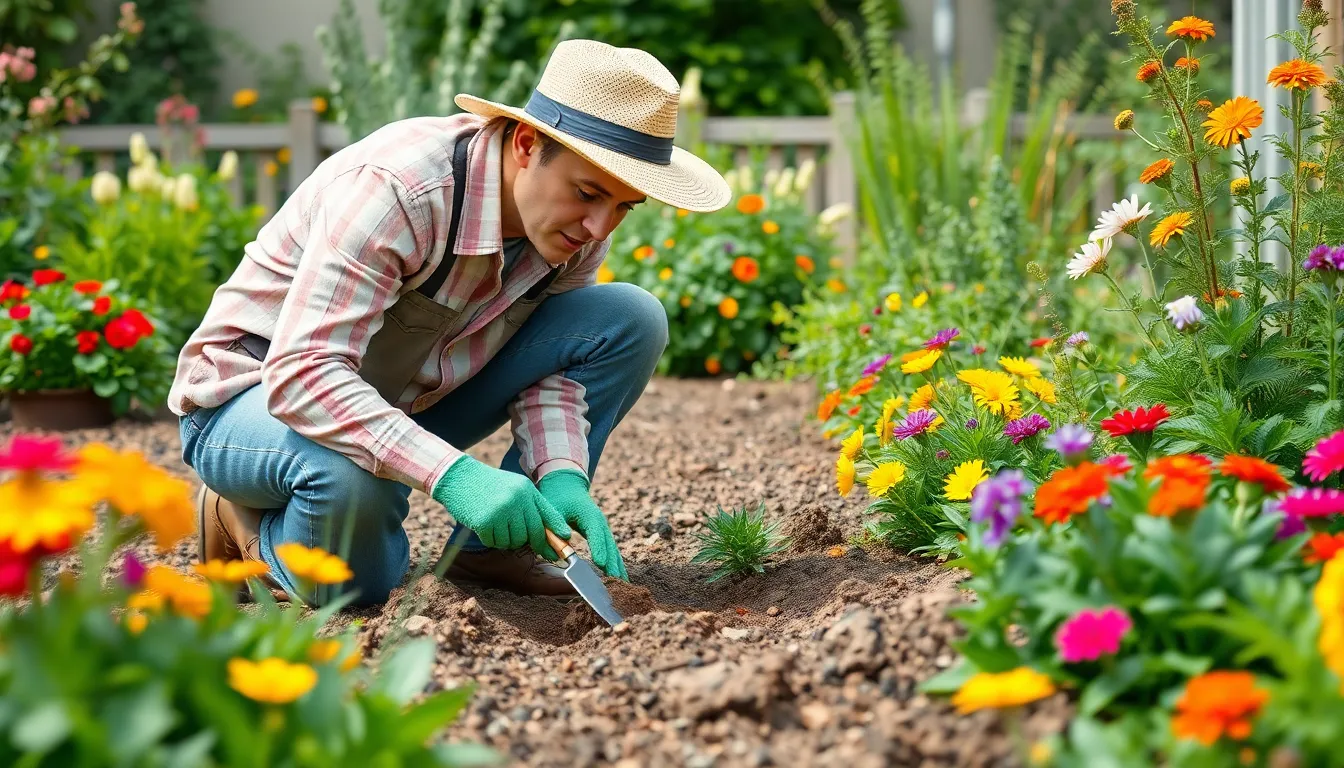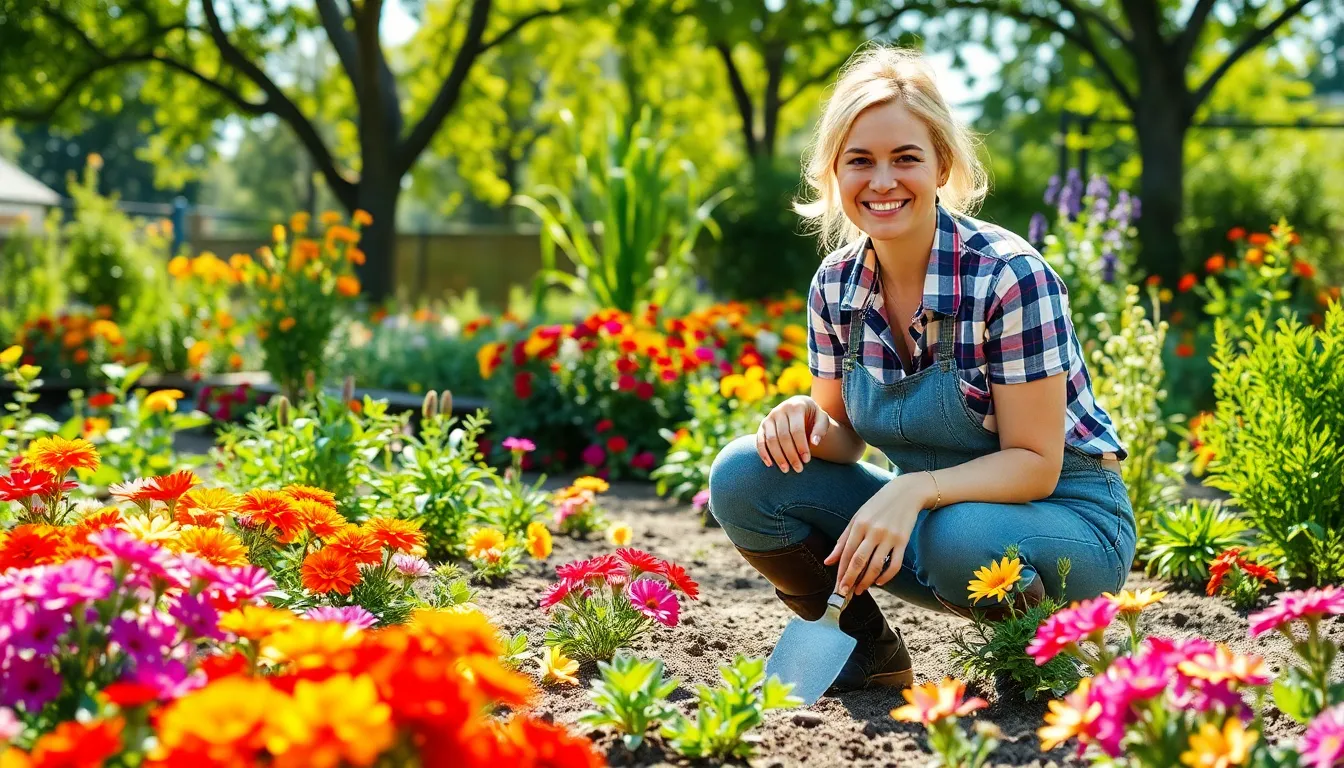Gardening isn’t just about digging in the dirt; it’s an art form that can turn anyone into a green-thumbed maestro. Whether you’re a seasoned pro or a newbie hoping not to kill your houseplants, there’s always something new to learn. Imagine impressing your friends with a flourishing garden that looks like it was plucked straight from the pages of a magazine.
Gardening Tips and Tricks
Gardening involves several practices that can elevate skills and knowledge. Here are some essential tips to enhance any gardening experience.
Choosing the Right Plants
Selecting plants suitable for the environment is crucial. Consider local climate conditions and hardiness zones when making choices. Native plants usually require less maintenance and support local ecosystems. It’s important to match plants with sunlight and water availability. Research plant characteristics before purchasing to ensure compatibility with the garden’s layout. For example, drought-resistant varieties make ideal selections for arid regions. Additionally, group plants based on their watering needs for optimal growth.
Understanding Your Soil
Soil forms the foundation for successful gardening. Testing soil pH helps determine suitability for various plants. Incorporating organic matter, like compost, boosts soil fertility and improves drainage. Depending on the texture, heavy clay soils may require amendments to enhance aeration. Prioritize regular soil testing to monitor nutrient levels and adjust accordingly. Mulching retains moisture and maintains consistent soil temperature. Beyond that, rotating crops improves soil health and reduces pest problems. Recognizing soil’s importance ensures robust plant growth and a flourishing garden.
Gardening Tools You Need

Essential tools make gardening easier and more enjoyable. Having the right equipment allows gardeners to work efficiently and achieve the desired results.
Must-Have Tools for Beginners
Gardeners should start with hand tools. A trowel assists in digging holes and transferring plants. Pruners serve to trim plants and remove dead growth. A garden fork helps aerate soil and mix in compost. Gloves protect hands while working with thorns and dirt. Finally, a watering can ensures plants receive the hydration they need. Each of these tools simplifies gardening tasks, making the beginner’s journey more manageable.
Maintaining Your Tools
Tool maintenance extends their lifespan and enhances performance. Cleaning tools after each use prevents rust and buildup. Sharpening blades regularly promotes efficiency and effectiveness. Storing tools in a dry place decreases damage from moisture. Inspecting tools for wear or breakage ensures safe usage and keeps gardeners prepared. Regular maintenance not only keeps gardening enjoyable but also saves money in the long run.
Effective Gardening Techniques
Gardening requires attention to detail and effective practices. Understanding various techniques can significantly enhance the gardening experience.
Watering Strategies
Proper watering techniques promote plant health. Timing of watering plays a vital role; early mornings or late afternoons prevent evaporation and ensure moisture absorption. Heaving a consistent schedule helps plants develop strong roots. Consider incorporating drip irrigation systems for efficient water delivery directly to the roots. Utilizing rain barrels can save water and reduce utility costs. Adjusting watering frequency according to weather conditions is essential; too much or too little can stress plants. Understanding specific plant needs regarding moisture also allows for better care.
Pest Control Methods
Implementing effective pest control methods protects garden health. Integrated Pest Management (IPM) combines biological, cultural, and mechanical strategies for holistic solutions. Encouraging beneficial insects like ladybugs naturally controls pests. Using physical barriers such as row covers can prevent insect damage without harsh chemicals. Applying organic pesticides as a last resort targets specific pests while minimizing harm to beneficial species. Regular monitoring for signs of infestations allows for timely interventions. Maintaining garden cleanliness reduces pest harborage, promoting a healthier growing environment.
Seasonal Gardening Tips
Seasonal gardening tasks enhance plant growth and ensure garden longevity. Following specific strategies for each season leads to thriving plants.
Spring Planting Secrets
Spring marks an opportune time for planting. Selecting hardy seeds or young plants ensures better establishment before summer heat. Gardeners should consider soil temperature, aiming for at least 60°F (16°C) for optimal seed germination. Preparing seedlings indoors provides a head start; transferring them outdoors after the last frost increases success. Fertilizing with balanced organic options promotes initial growth. Organizing plants by their height allows for efficient sunlight exposure; taller plants should not shade shorter ones. Watering consistently, especially during early growth stages, helps seedlings thrive.
Fall Preparation Tips
Preparing gardens for fall enhances winter resilience. Testing soil pH remains essential; adjusting it boosts next season’s crop performance. Incorporating compost improves soil structure and nutrients, aiding future plant growth. Clear spent plants to reduce pests and diseases, while leaving root systems to decompose enriches the soil. Mulching in late fall insulates plant roots and conserves moisture. Covering perennial beds with leaf litter cultivates a protective barrier against freezing temperatures. Planning crop rotation minimizes soil depletion; alternating plant families strengthens garden health for upcoming seasons.
Conclusion
Gardening offers a rewarding experience that fosters creativity and connection to nature. By applying the tips and tricks shared in this article, anyone can cultivate a thriving garden that reflects their unique style and preferences.
Embracing the right techniques and tools not only simplifies the gardening process but also enhances the joy of nurturing plants. Staying informed about seasonal needs and local conditions ensures ongoing success and satisfaction.
With dedication and patience, each gardener can transform their outdoor space into a vibrant oasis that brings beauty and joy for years to come.

